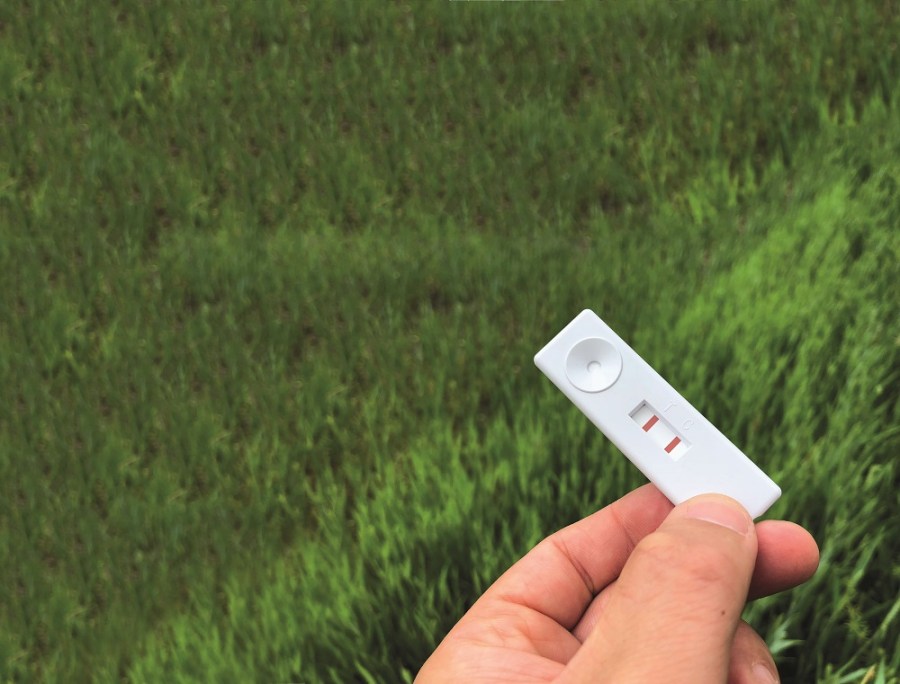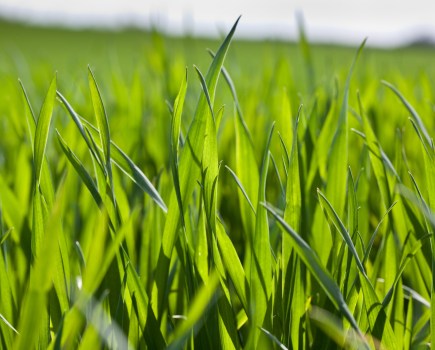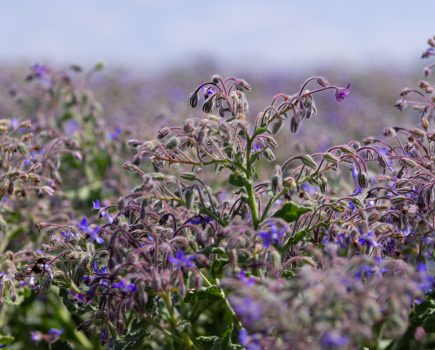It’s a world first and spun out of one of the biggest weed research projects the UK has seen. CPM assesses a ‘pregnancy-test style’ kit for diagnosing blackgrass resistance.
This adds science into the frame of blackgrass assessments.
By Tom Allen-Stevens
It’s long been said there’s no quick fix for resistant blackgrass, arguably one of UK Farming’s biggest problems and recently estimated to cost the UK £0.4bn and 0.8M tonnes of wheat every year. But now there’s a quick scientific measurement for it, and it’s as easy and as cheap to carry out as a pregnancy test.
BReD (Blackgrass Resistance Diagnostic) is a lateral-flow device that will give you important information about how resistant your blackgrass is in just 10 mins. The kit costs £40+VAT, which includes enough devices and mixing solution for five separate tests. What’s more, there are 400 kits that are now being made available for free, and CPM readers are encouraged to apply.
The new test, launched at Cereals 2018, is a world first, and one of the outcomes of the Blackgrass Resistance Initiative (BGRI), a £2.8M BBSRC and AHDB-funded project that completed two years ago. Developing an in-field diagnostic test was one of the core aims of the project, and it’s been validated and refined as the project progressed.
“We now have a high degree of understanding of the molecular mechanisms underpinning the evolution of metabolic herbicide resistance (MHR) and how we can counteract it,” notes Prof Robert Edwards of Newcastle University, who’s led that element of the project. “That’s helped us develop this diagnostic test.”
The breakthrough came right at the start of the project in 2014 when researchers pinpointed a protein called glutathione transferase, AmGSTF1, that was linked to MHR. Unlike target site resistance, MHR is caused by a complex set of genes being activated following repeated herbicide exposure over time. Changes in gene expression that lead to herbicide resistance are selected for and this results in the increased production of AmGSTF1. The more of this protein released, the better the plant becomes at overcoming the herbicide.
“It’s the same type of protein associated with multiple drug resistance in humans,” notes Robert. “Having identified it as a functional biomarker of resistance, we could develop antibodies that would detect how much protein a plant has and therefore how resistant it is.”
This quantitative assay forms the basis of the lateral-flow device, with the kit developed by commercial partner Mologic. “These diagnostic kits are used throughout human healthcare, most commonly in pregnancy tests. But this was the first time it had ever been used to gauge herbicide resistance in plants.”
But how reliable was it, and would it work in the field? “We needed to be sure the kit would deliver scientifically valid diagnostics when used by people with little scientific background,” continues Robert.
“We worked with agronomists from a number of companies who tested kits out in the field, as well as a group of farmers. This proved it was easy to use. We also tested it against a range of blackgrass samples with a known level of resistance and found the kit offered a good correlation with traditional lab-based testing. But the best resource we had to field-test the kits was the BGRI network of participating farms.”
There were 64 farms from Oxon to Yorks where blackgrass populations had been mapped, with samples taken each year in another part of the project aimed at understanding population dynamics, headed by Rothamsted Research.
“MHR is a very complicated beast to work with,” notes Rothamsted’s Richard Hull. “But we now understand a lot more about how it develops in the field.”
The monitoring confirmed MHR as the most common form of resistance. What’s more the plants develop cross-resistance to other herbicides and modes of action. “We found that, while populations will vary significantly in density across a field, previous work has shown the level of resistance will be pretty uniform, although this can differ from one field to another,” he says.
Research from the project indicates that the rate at which MHR increases is related to the total amount of herbicide used. “There’s no risk-free herbicide – most of them have the potential to raise the level of MHR, although the rate depends on the active used. It’s also a numbers game – the more plants you expose to herbicides, the more likely you will drive resistance.”
That’s not to say herbicides can’t continue to deliver effective control even in resistant populations. “As resistance has increased, contact chemistry, which is affected by both MHR and TSR, has become superceded by residual herbicides such as flufenacet-based products, which deliver on average 70% control,” reports Richard.
“What we have found through returning to the same fields is that there’s a definite shift in resistance over time. We have good records from all the fields in the network of methods used and herbicides applied to control blackgrass, so have a really good idea what works. While population densities can change, depending on management, it’s predicted the levels of resistance always get worse year-on-year.”
So Richard feels that the BReD kits are most useful as an early warning. “Farmers in Worcestershire, Herefordshire, Wales, the north of England and the South West are beginning to find blackgrass in crops. The last thing you want in these areas is for blackgrass to get out of hand. So these are the populations that should be tested and monitored, with management practice altered accordingly.”
He also recommends using the BReD kits when taking on new land. “If you plough a field, it’s also worth testing both before and after, to assess the level of resistance in the population you bring up. But test 12 months apart to ensure both populations are tested at the same time of year.”
Robert notes that the evolution of resistance is a constant process. “It’s like living with a long-term illness. You’ll never cure it and it can become a serious problem really quickly. The best way to manage it is to understand it and learn how to keep it under control.”
The types of resistance
Target site resistance (TSR). Mutations in the proteins targeted by particular chemicals can make weeds less sensitive to them. This form of resistance is relatively well understood and plants are either resistant or susceptible to individual herbicides. It can be countered by the rotational use of herbicides with differing modes of action.
Metabolic or multiple herbicide resistance (MHR). Weeds become more tolerant of a broad range of herbicides, irrespective of their chemistry or mode of action. Generally, this is due to the weed being better able to detoxify crop protection agents, and is characterised by a more gradual shift towards total resistance. MHR is also termed non-target site resistance (NTSR). As MHR is poorly understood, the BGRI focused on it.
A blackgrass approach underpinned by science
For Wilts-based agronomist with Pearce Seeds, Sam Pociecha, the BReD kit provides confidence to give the right advice and confirmation that what he’s seeing in the field is resistance.
“Many of the efficacy problems associated with blackgrass herbicides are down to application or timing, particularly with Atlantis (mesosulfuron+ iodosulfuron),” he notes.
Having read about it first in CPM, Sam saw the BReD kit demonstrated at a Pearce open day in 2018 and decided to try it on a few farms with suspected resistance issues. “In one case it’s confirmed where pendimethalin has caused a high level of resistance, but in another, where resistance to Atlantis was suspected, that turned out not to be the case.”
Sam’s used around 20 kits to date, and notes the results require a degree of interpretation. “It won’t give an indication of target site resistance, and you may have both. But TSR is relatively easy to spot in the field, especially if you can rule MHR in or out.
“It’s especially useful where you find a low level of resistance appearing – that’s the opportunity to highlight and make management changes before a blackgrass problem gets out of hand. It can tell you whether it’s worth applying Avadex (triallate) or taking the field out of winter cropping altogether.”
He also encouraged Pearce Seeds to invest in a cube to give a digital read-out of herbicide resistance. “This is useful for benchmarking – the data is available for known populations, such as Peldon, so you can gauge the relative resistance level. You also get an accurate idea of resistance shifts.”
For this reason, he samples at the same time of year. “You can do the test in Feb or March but it takes a little longer for the band to show. I test in June, when plants are bigger to sample and may have grown through a treatment program, which allow a proper assessment of that program. It’s also the time of year I have more time.”
Sam believes the BReD test will become an increasingly important part of the IPM toolbox. “There’s far more to providing a good agronomy service than just recommending products. This adds science into the frame of blackgrass assessments, and helps in terms of justifying any herbicide applications you make. You have confidence in it because there’s a robust level of science that’s gone into developing the kit.”
Interested in a free slice of BReD?
Newcastle University have 400 kits they are offering for free to growers and agronomists. CPM readers in particular are encouraged to apply.
“We want to gather information on how farmers are using it, so in return we’ll ask you to complete a brief questionnaire,” says research associate Dr Nawaporn Onkokesung.
The kits are very easy to use and come completely self-contained, but there’s a process to preparing samples that must be followed to gather accurate results, she notes. “You can use it at any growth stage, as long as there is green material. But it’s best to test at the same time of year so that you can get comparative results – temperature and size of plant can affect the result.”
One plant per device should be tested, using a leaf tip cut into 3cm strips. These are placed in a small bottle with buffer solution added and shaken vigorously with ball bearings for exactly 30secs. Three drops of the extract are applied to the aperture of the device and it takes around 15 mins for the red line to show. The stronger the band, the more resistant the blackgrass plant.
“While this will give you a reliable indication, you can purchase a reusable cube for £350 from Mologic that clips onto the device and gives you a numerical read-out. This is useful for comparative analysis,” says Nawaporn.
The assay has been specifically prepared for blackgrass but can be used to assess levels of resistance in other grassweeds, she notes. “It will give you an indication if there is MHR in wild oats, ryegrass and bromes as it’s the same protein the kit detects. But it will need a different quantitative assay to assess accurately the level of resistance.
“We’re keen to know the demand from farmers in a kit for other grassweeds, so would like to hear from growers who would find it useful.” The kits are not suitable for assessing resistance to glyphosate, however, adds Nawaporn.
Those interested in receiving a free kit should email their postal address to nawaporn.onkokesung@newcastle.ac.uk Put “BReD trial by” in the subject field, specifying the intended sampling date, allowing two weeks for fulfilment. One free kit per applicant.
Research Roundup
This Research Briefing article forms part of the delivery of knowledge exchange from a public and grower-funded research project. CPM would like to thank Newcastle University for its support and in providing privileged access to staff and others involved in helping put it together.
The Blackgrass Resistance Initiative (BGRI) ran from April 2014 to March 2018. Delivered across five work packages, it examined the evolution and management of herbicide
resistance in blackgrass focusing on multiple herbicide resistance (MHR), from genes to agro-ecosystems. Led by Newcastle University, scientific partners included Rothamsted Research, Zoological Society of London and Universities of Sheffield, Reading, Edinburgh and York. Its total cost was £2.8M, funded mostly by BBSRC with £280,000 funded by AHBD.




